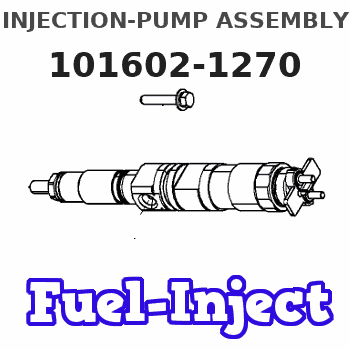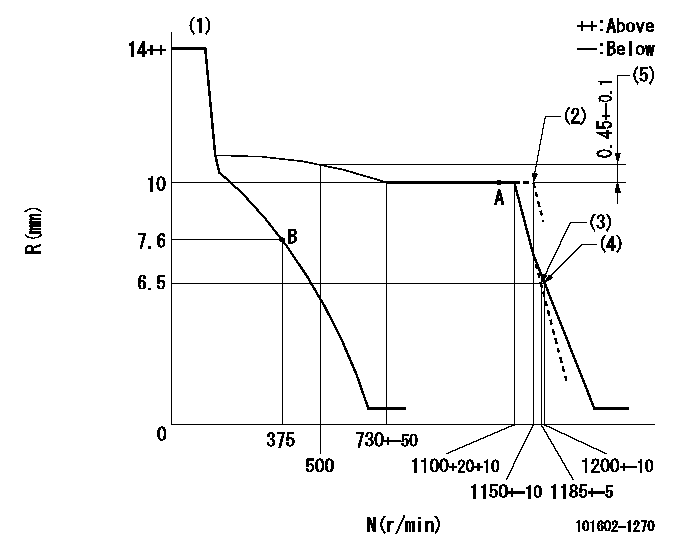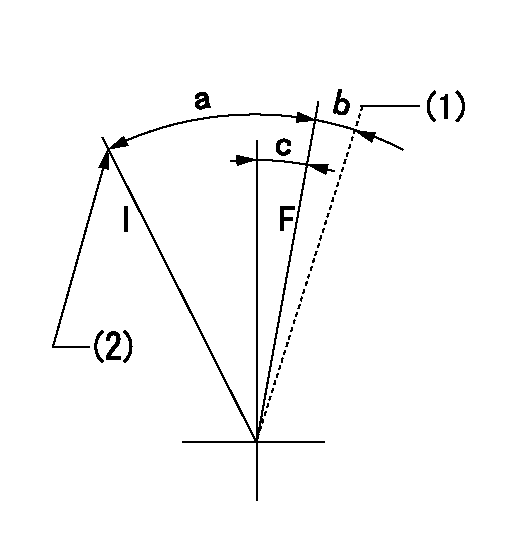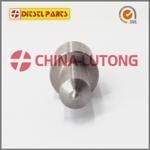Information injection-pump assembly
ZEXEL
101602-1270
1016021270

Rating:
Service parts 101602-1270 INJECTION-PUMP ASSEMBLY:
1.
_
5.
AUTOM. ADVANCE MECHANIS
6.
COUPLING PLATE
8.
_
9.
_
11.
Nozzle and Holder
ME070516
12.
Open Pre:MPa(Kqf/cm2)
17.7{180}
15.
NOZZLE SET
Cross reference number
ZEXEL
101602-1270
1016021270
Zexel num
Bosch num
Firm num
Name
101602-1270
INJECTION-PUMP ASSEMBLY
Calibration Data:
Adjustment conditions
Test oil
1404 Test oil ISO4113 or {SAEJ967d}
1404 Test oil ISO4113 or {SAEJ967d}
Test oil temperature
degC
40
40
45
Nozzle and nozzle holder
105780-8140
Bosch type code
EF8511/9A
Nozzle
105780-0000
Bosch type code
DN12SD12T
Nozzle holder
105780-2080
Bosch type code
EF8511/9
Opening pressure
MPa
17.2
Opening pressure
kgf/cm2
175
Injection pipe
Outer diameter - inner diameter - length (mm) mm 6-2-600
Outer diameter - inner diameter - length (mm) mm 6-2-600
Overflow valve
131424-3720
Overflow valve opening pressure
kPa
255
255
255
Overflow valve opening pressure
kgf/cm2
2.6
2.6
2.6
Tester oil delivery pressure
kPa
157
157
157
Tester oil delivery pressure
kgf/cm2
1.6
1.6
1.6
Direction of rotation (viewed from drive side)
Left L
Left L
Injection timing adjustment
Direction of rotation (viewed from drive side)
Left L
Left L
Injection order
1-5-3-6-
2-4
Pre-stroke
mm
3.3
3.25
3.35
Beginning of injection position
Governor side NO.1
Governor side NO.1
Difference between angles 1
Cal 1-5 deg. 60 59.5 60.5
Cal 1-5 deg. 60 59.5 60.5
Difference between angles 2
Cal 1-3 deg. 120 119.5 120.5
Cal 1-3 deg. 120 119.5 120.5
Difference between angles 3
Cal 1-6 deg. 180 179.5 180.5
Cal 1-6 deg. 180 179.5 180.5
Difference between angles 4
Cyl.1-2 deg. 240 239.5 240.5
Cyl.1-2 deg. 240 239.5 240.5
Difference between angles 5
Cal 1-4 deg. 300 299.5 300.5
Cal 1-4 deg. 300 299.5 300.5
Injection quantity adjustment
Adjusting point
A
Rack position
10
Pump speed
r/min
1050
1050
1050
Average injection quantity
mm3/st.
86.5
85.5
87.5
Max. variation between cylinders
%
0
-2.5
2.5
Basic
*
Fixing the lever
*
Injection quantity adjustment_02
Adjusting point
B
Rack position
7.6+-0.5
Pump speed
r/min
375
375
375
Average injection quantity
mm3/st.
9.7
8.2
11.2
Max. variation between cylinders
%
0
-15
15
Fixing the rack
*
Test data Ex:
Governor adjustment

N:Pump speed
R:Rack position (mm)
(1)Target notch: K
(2)Set at delivery
(3)Main spring setting
(4)Set idle sub-spring
(5)Rack difference from N = N1
----------
K=14 N1=1050r/min
----------
----------
K=14 N1=1050r/min
----------
Speed control lever angle

F:Full speed
I:Idle
(1)At shipping
(2)Stopper bolt setting
----------
----------
a=(21deg)+-5deg b=(2deg) c=(10deg)+-5deg
----------
----------
a=(21deg)+-5deg b=(2deg) c=(10deg)+-5deg
Stop lever angle

N:Pump normal
S:Stop the pump.
(1)At delivery
----------
----------
a=26deg+-5deg b=53deg+-5deg
----------
----------
a=26deg+-5deg b=53deg+-5deg
Timing setting

(1)Pump vertical direction
(2)Position of coupling's tooth at No 1 cylinder's beginning of injection
(3)B.T.D.C.: aa
(4)-
----------
aa=15deg
----------
a=(0deg)
----------
aa=15deg
----------
a=(0deg)
Information:
Batteries
Install batteries that will provide adequate cold cranking amps (CCA) in order to start the engine and operate the engine at the coldest expected temperatures. Maintain proper battery electrolyte level. Keep all batteries fully charged to a corrected specific gravity of 1.250 or above and keep the batteries warm. Heating of the battery compartment or storage in a warm location will maximize the cranking power of the battery. The temperature of the batteries has a considerable effect on the available power. The batteries will not have enough power for cranking the engine and starting the engine if the batteries are too cold, even with a warm engine. Batteries typically have only fifty percent of the capability at −10 °C (14 °F) versus 27 °C (81 °F). Only ten percent of the original power is available at a temperature of −35 °C (−31 °F). Check the condition of the batteries and the electrolyte level in each battery cell except for maintenance free batteries. Remove the battery filler caps. Maintain the electrolyte level to the bottom of the openings for the battery filler caps with distilled water. If distilled water is not available, use clean water, that is low in minerals. Do not use artificially softened water or drinking water. The salt in artificially softened water will damage the efficiency of your batteries. At the proper charging rate in a moderate climate, a battery should not require more than 30 cc (1 oz) of water per cell per week. Check the cells weekly in arctic temperatures. The cell water usage could be higher.Block Heaters
A cylinder block coolant heater can improve the startability and a cylinder block coolant heater can reduce the warm-up time by heating the coolant that surrounds the combustion chambers. A cylinder block coolant heater that is powered by electricity can be activated immediately after the engine is stopped. A cylinder block coolant heater will reduce the temperature that will require ether for starting the engine. An effective block heater is a 1250 watt to 1500 watt unit. Contact your truck dealer for more information.Air Inlet Heaters and Ether Starting Systems
If equipped with an air inlet heater (AIH) for cold weather starting, do not use types of starting aids such as ether. Such use could result in an explosion and injury.
When starting the engine with ether, follow these starting procedure instructions carefully. Use ether sparingly and spray it ONLY WHILE CRANKING THE ENGINE. Excessive ether use can cause piston and ring damage. Ether should be used only for cold weather starting.
As temperatures drop below 0 °C (32 °F), starting a cold engine may require assistance in the form of ether starting aids or air inlet heaters. An automatic metered ether injection system is preferred over a manual system. An automatic system reduces the risk of engine damage by minimizing the operator's responsibility in order to correctly determine the quantity of ether that is required. Excessive ether will damage the engine and excessive ether will void the manufacturer's
Install batteries that will provide adequate cold cranking amps (CCA) in order to start the engine and operate the engine at the coldest expected temperatures. Maintain proper battery electrolyte level. Keep all batteries fully charged to a corrected specific gravity of 1.250 or above and keep the batteries warm. Heating of the battery compartment or storage in a warm location will maximize the cranking power of the battery. The temperature of the batteries has a considerable effect on the available power. The batteries will not have enough power for cranking the engine and starting the engine if the batteries are too cold, even with a warm engine. Batteries typically have only fifty percent of the capability at −10 °C (14 °F) versus 27 °C (81 °F). Only ten percent of the original power is available at a temperature of −35 °C (−31 °F). Check the condition of the batteries and the electrolyte level in each battery cell except for maintenance free batteries. Remove the battery filler caps. Maintain the electrolyte level to the bottom of the openings for the battery filler caps with distilled water. If distilled water is not available, use clean water, that is low in minerals. Do not use artificially softened water or drinking water. The salt in artificially softened water will damage the efficiency of your batteries. At the proper charging rate in a moderate climate, a battery should not require more than 30 cc (1 oz) of water per cell per week. Check the cells weekly in arctic temperatures. The cell water usage could be higher.Block Heaters
A cylinder block coolant heater can improve the startability and a cylinder block coolant heater can reduce the warm-up time by heating the coolant that surrounds the combustion chambers. A cylinder block coolant heater that is powered by electricity can be activated immediately after the engine is stopped. A cylinder block coolant heater will reduce the temperature that will require ether for starting the engine. An effective block heater is a 1250 watt to 1500 watt unit. Contact your truck dealer for more information.Air Inlet Heaters and Ether Starting Systems
If equipped with an air inlet heater (AIH) for cold weather starting, do not use types of starting aids such as ether. Such use could result in an explosion and injury.
When starting the engine with ether, follow these starting procedure instructions carefully. Use ether sparingly and spray it ONLY WHILE CRANKING THE ENGINE. Excessive ether use can cause piston and ring damage. Ether should be used only for cold weather starting.
As temperatures drop below 0 °C (32 °F), starting a cold engine may require assistance in the form of ether starting aids or air inlet heaters. An automatic metered ether injection system is preferred over a manual system. An automatic system reduces the risk of engine damage by minimizing the operator's responsibility in order to correctly determine the quantity of ether that is required. Excessive ether will damage the engine and excessive ether will void the manufacturer's
Have questions with 101602-1270?
Group cross 101602-1270 ZEXEL
Mitsubishi
Mitsubishi
Mitsubishi
Mitsubishi
101602-1270
INJECTION-PUMP ASSEMBLY
